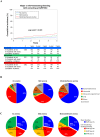Anemia in Patients with Severe Aortic Stenosis
- PMID: 30760807
- PMCID: PMC6374463
- DOI: 10.1038/s41598-018-36066-z
Anemia in Patients with Severe Aortic Stenosis
Abstract
Prognostic impact of anemia complicating severe aortic stenosis (AS) remains unclear. We assessed the impact of anemia on cardiovascular and bleeding outcomes in 3403 patients enrolled in the CURRENT AS registry. 835 patients (25%) had mild (hemoglobin 11.0-12.9 g/dl for men/11.0-11.9 g/dl for women) and 1282 patients (38%) had moderate/severe anemia (Hb ≤ 10.9 g/dl) at diagnosis of severe AS. Mild and moderate/severe anemia were associated with significantly increased risks relative to no anemia (hemoglobin ≥13.0 g/dl for men/≥12.0 g/dl for women) for the primary outcome measure (aortic valve-related death or heart failure hospitalization) in the entire population [hazard ratio (HR): 1.30; 95% confidence interval (CI): 1.07-1.57 and HR: 1.56; 95%CI: 1.31-1.87, respectively] and in the conservative management stratum (HR: 1.73; 95%CI: 1.40-2.13 and HR: 2.05; 95%CI: 1.69-2.47, respectively). Even in the initial aortic valve replacement stratum, moderate/severe anemia was associated with significantly increased risk for the primary outcome measure (HR: 2.12; 95%CI: 1.44-3.11). Moreover, moderate/severe anemia was associated with significantly increased risk for major bleeding while under conservative management (HR: 1.93; 95%CI: 1.21-3.06). These results warrant further study to explore whether better management of anemia would lead to improvement of clinical outcomes.
Conflict of interest statement
The authors declare no competing interests.
Figures



References
Publication types
MeSH terms
LinkOut - more resources
Full Text Sources
Medical
Research Materials

